May 30, 2019

By Bob Hartzler
Delays in planting get the headlines (for good reason), but another issue with prolonged wet periods is the inability to manage weeds and cover crops in a timely fashion. Here is a brief review of some of the problems that may be encountered this spring:
Large winter annual weeds and cover crops. Effective management of vegetation present at planting is critical. As termination is delayed, the weeds or cover crop will become more difficult to kill. While glyphosate is better at controlling larger weeds than other products, it is essential to take steps to maximize its performance under these conditions.
Factors that may reduce glyphosate activity include tank mixes with other herbicides, especially those that cause rapid foliar injury, and the use of UAN liquid nitrogen (28% or 32% N) as a herbicide carrier. Be sure to use recommended rates of AMS (ammonium sulfate) and increase the spray volume in fields with dense vegetation. Also, avoid applications toward twilight and don’t reduce glyphosate rates.
The use of 2,4-D is often included with glyphosate to enhance control of certain broadleaf species. Follow the planting interval restriction (seven days for 0.25 pound 2,4-D LVE applied per acre in most situations) when this product is used.
Delays applying preemergence herbicides. What if application of preemergence herbicides is delayed following planting? The rush to get fields planted has undoubtedly resulted in sprayers not keeping up with the planters. As soon as fields dry, it will be important to determine whether crops and weeds have emerged, and then identify appropriate treatments.
Most corn preemergence herbicides can be applied after the crop has emerged, but there is a wide range in how much activity the products have on emerged weeds. In fields with emerged weeds, determine the need to include additional herbicides to control the established weeds.
Corn that emerges in cool, wet conditions will likely be under stress, reducing herbicide tolerance. If fields have low densities of small weeds, it may be better to delay application a few days to allow the corn vigor to improve. But in fields with high weed densities, the weeds may pose a greater threat to the crop than the risk of herbicide injury.
Unlike in corn, preemergence options for soybeans are greatly limited when the crop has emerged, emphasizing the importance of getting the herbicide on as soon as conditions allow for field operations to resume. Products containing flumioxazin (Valor, Fierce, etc.), saflufenacil (Sharpen, Optill, etc.), sulfentrazone (Authority products), and metribuzin (Boundary, Canopy, etc.) cannot be applied after soybeans have emerged.
In fields where the crop emerges prior to herbicide application, the best option is to apply an appropriate postemergence product as soon as the field is fit and include a Group 15 herbicide to provide control into the growing season. Addition of a Group 2 herbicide (e.g. imazethapyr, cloransulam-methyl) or fomesafen (HG 14) could improve residual control of certain broadleaf species.
Cool conditions, slowed crop development. While some areas of the state were able to get corn planted in a somewhat timely fashion, the below-average temperatures have slowed emergence and development of the crop. The slow canopy growth will require preemergence herbicides to provide longer control than in more typical springs.
The longevity of preemergence control will also be reduced in fields receiving above-average rain. Thus, fields that were planted and sprayed in a timely fashion should be scouted early enough to allow remedial treatments to be made if the preemergence program breaks down early.
Switch from corn to beans. If planting is delayed further, some farmers may consider switching fields intended for corn to soybeans. If herbicides for the corn crop were applied this spring, or last fall, the option to change crops may be eliminated. Check labels of any applied products to determine the rotational interval for soybeans.
Weeds in prevented planting acres. Continued planting delays or flooding may result in some fields qualifying for prevented planting payment. It is as important to have a weed management plan for these fields as for other fields since allowing weeds to survive will result in a dramatic increase in weed pressure for future years.
Planting a suitable cover crop to provide significant ground cover into a weed-free seedbed is the most important step in managing weeds in these fields.
Hartzler is an ISU Extension weed specialist and professor of agronomy. Contact him at [email protected].
You May Also Like




